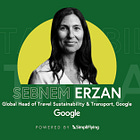In this episode of our ‘Sustainability in the Air’ podcast, Dan Rutherford, Senior Director of Research at the International Council on Clean Transportation (ICCT), returns for his second appearance on the podcast. He speaks with SimpliFlying CEO Shashank Nigam on the latest developments, partnerships, and challenges in reducing aviation emissions and achieving net zero by 2050 since his last appearance in 2022.
The ICCT is a research-based environmental non-profit comprising scientists and engineers who work closely with environmental regulators to reduce transportation emissions. In the conversation, Rutherford highlights the role of multi-stakeholder initiatives and partnerships between organisations like ICCT and airlines, manufacturers, and other industry players in driving the transition to a cleaner, more sustainable future for aviation.
Here are the key highlights of the conversation:
The travel impact model with Google (02:21)
The importance of changing consumer behaviour (10:06)
The importance of sustainable aviation fuel (SAF) adoption (15:57)
Why aircraft must have lifecycle zero-emissions by 2035 (20:34)
How policy mandates can nudge SAF production and uptake (29:47)
Can a frequent flyer levy pay for decarbonisation? (34:23)
Rapid fire! (46:32)
Keep reading for a quick overview of the episode
A Rutherford refresher
While Universal Hydrogen and Harbour Air have previously been featured twice on our podcast, Rutherford is the first alumnus to return – and fittingly so. For the curious, here’s a quick comparison of how the two episodes stack up in terms of similarities, continuations and divergences.
What hasn’t changed is the obvious: in both episodes, Rutherford emphasises the importance of SAF in achieving net zero emissions by 2050, while expressing concerns about the use of food crops for SAF production. He reiterates the need for government policies, mandates (including frequent flyer levies), and incentives, as well as consumer awareness and action, to drive the adoption of cleaner technologies and fuels in the industry.
In this episode, however, he provides more detailed information on the Travel Impact Model and delves deeper into the challenges of decarbonising aviation. It also includes a more in-depth discussion of the potential and pitfalls of supersonic flight, collaborative efforts, and industry engagement while interspersing his personal experiences with flying with the role of governments in setting policies.
Why the Travel Impact Model matters
Since 2022, ICCT has expanded its partnerships beyond industry partners to include governments and other non-governmental organisations such as the Science Based Targets Initiative (SBTi) and RMI. These collaborations have allowed ICCT to apply its research directly to various projects and initiatives aimed at reducing emissions.
For instance, the Travel Impact Model (TIM) developed in partnership with Google is a key focus of ICCT's recent work. TIM aims to provide consumers with accurate, precise, and transparent emissions estimates when booking flights, enabling them to make more environmentally conscious decisions.
The following core principles guide the development of TIM:
Accuracy: TIM strives to closely align modelled emissions with actual airline data.
Precision: The model aims to distinguish between more and less carbon-intensive flights.
Transparency: Open-source models and data sources are used to ensure reliability and credibility.
While the TIM is a prediction and has limitations, it is designed to reward airlines for their efforts in reducing emissions through various means, such as newer planes, higher load factors, carrying belly cargo, or adopting SAF.
5 key challenges and opportunities for reaching net zero
1. Tackling imbalances
At its heart, climate change is deeply about inequity. The poorest will be the most affected, while those who have caused the emissions – rich countries – will most likely feel it less or have the resources to manage the impact. Rutherford points out the stark imbalance in historical emissions, with high-income countries responsible for approximately 70% of aviation emissions to date, despite representing only 16% of the world's population.
Moreover, achieving net zero emissions in aviation will cost an estimated $4-5 trillion. With the entire global airline industry generating around $1 trillion in revenue during a good year, the question of who will bear these costs is a critical one. Rutherford suggests that the ideal split for funding the transition would be 20% from governments and 80% from airlines and, ultimately, consumers. He emphasises the need for an equitable approach to generating revenue, ensuring that the poorest consumers in developing countries are not priced out of the market.
2. Leaning on SAF
Rutherford shares a striking example highlighting the challenge of achieving carbon neutrality: He argues that if all planes currently in service were to operate until retirement, they would consume 40% of the net zero CO2 budget through 2050.
Moreover, projections suggest that by around 2035, every new aircraft delivered will need to be zero-emission over its lifetime to meet the net zero goal.
Hence, given the long lifespan of aircraft and the slow development of alternative technologies like hydrogen, there is a pressing need for massive adoption of SAF to bridge the gap. Rutherford insists that without significant uptake of SAF, achieving the 2050 target – already daunting enough – would be extremely challenging.
Of course, the widespread adoption of SAF is already in jeopardy due to the current limited production and uneven distribution. Rutherford notes that even the most proactive airlines are struggling to incorporate more than 1% of SAF into their fuel mix. Increasing SAF production and ensuring its equitable distribution across regions will be critical in achieving significant emissions reductions.
3. Creating the right incentives and regulations
Rutherford stresses the crucial role of SAF mandates in driving the adoption of cleaner fuels.
He praises the European Union's ReFuelEU mandate, which sets strict feedstock requirements and gradually increases the required percentage of SAF over time. Such mandates create a clear framework for airlines and fuel producers to work towards, ensuring a steady transition to cleaner fuels. (The EU aims to increase the share of mandatory SAF in its airports from 2% in 2025 to 70% by 2050, while the share of synthetic fuels is set to grow from 1.2% in 2030 to 35% by 2050.)
In sharp contrast to the EU, the United States is grappling with a debate on which types of SAF should qualify for incentives. Rutherford highlights concerns about the environmental impact of crop-based fuels, such as those derived from corn and soybeans. He argues that using food crops for fuel production could lead to unintended consequences, such as increased deforestation and land use changes, which could negate the emissions reductions achieved by SAF.
4. Implementing a frequent flyer levy
According to Rutherford, a frequent flyer levy, where taxes would escalate based on the number of flights taken per year, could be a potential way to fund decarbonisation. This approach addresses the problem of inequity since not everyone is penalised equally. The majority of revenue will be generated from the wealthiest 10% of the population, who are responsible for a disproportionate share of flights.
Rutherford says such a levy would not be very hard to implement. After all, airlines are already adept at price discrimination and segmenting customers based on their travel habits and willingness to pay. Leveraging this expertise could help in designing an equitable taxation system that minimises the impact on infrequent flyers and those with lower incomes.
"We've analysed this, comparing a flat tax of $25 per flight to an escalating frequent flyer levy, where everyone's first flight in a year is free, their second flight is taxed $9, and then up and up and up escalating to something like $200 for the 20th flight. Such a levy would be even more progressive than flat taxation."
5. Empowering customers and driving action
Rutherford energetically advocates the importance of consumer awareness and action in driving change within the industry. For example, tools like TIM play a crucial role in empowering consumers to make environmentally conscious choices. By providing accurate, precise, and transparent emissions data at the point of booking, these tools can nudge consumers towards choosing lower-carbon options, creating a virtuous cycle of demand for cleaner flights.
Rutherford also draws a clever analogy to calorie counts on restaurant menus – he believes that such information has influenced chef behaviour more than diner behaviour. Similarly, he explains that the visibility of emissions data could prompt airlines to seek ways to reduce their carbon footprint proactively, even if the consumer uptake is gradual.
"I think making sure that consumers understand the impact of their flying so they choose less emitting flights is the key enabling step from the consumer side. In a year from now, I would love to see 10% of people in the world choosing tickets based on their emissions."
‘Sustainability in the Air’ is the world’s leading podcast dedicated to sustainable aviation. Through in-depth conversations with top aviation leaders, we break through the clutter and provide a clear roadmap for a net-zero future.
















